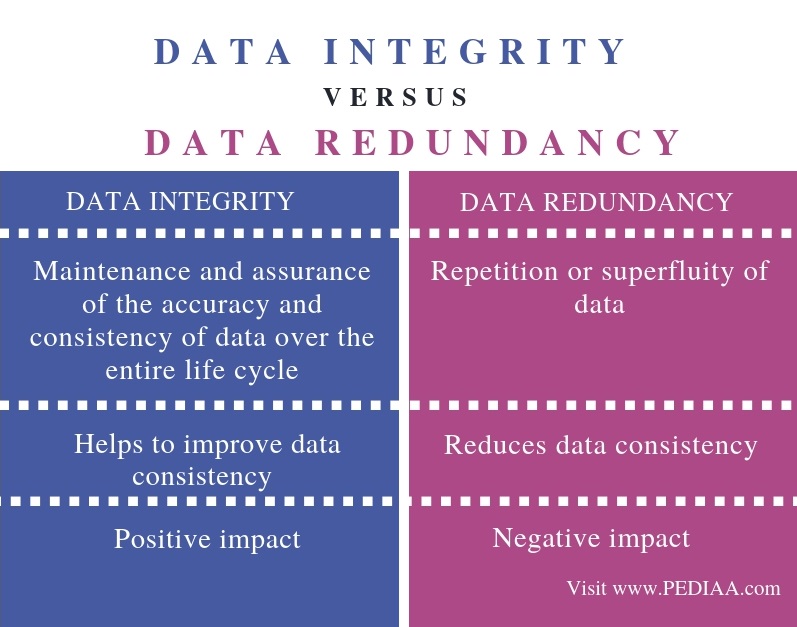Database Integrity Definition
Data integrity refers to the correctness and completeness of data with respect to a database. Inconsistent database table and entity definitions.
Data integrity ensures all the above mentioned issues are not injected into the database while it is designed.

Database integrity definition. Data integrity is the overall accuracy completeness and consistency of data. The concept of data integrity may be used to define a state a procedure or a feature and is sometimes used interchangeably with data quality. Each and every time a table insert update delete or alter operation is.
Integrity constraints in Database Management Systems DBMS are a set of rules that are applied on the table columns or relationships to ensure that the overall validity integrity and consistency ie. Compromised data after all is of little use to enterprises not to mention the dangers presented by sensitive data loss. Entity Integrity ensures that there are no duplicate records within the table and that the field that identifies each record within the table is unique and never null.
Data integrity refers to the overall accuracy completeness and reliability of data. It is maintained by a collection of processes rules and standards implemented during the design phase. Integrity Rules are imperative to a good database design.
Types of Integrity Constraints. The second type of integrity semantic data integrity refers to the meaning of data and the relationships that need to be maintained between different types of. A good database will enforce data integrity whenever possible.
Data integrity is a fundamental component of information security. Integrity constraints ensure that the data insertion updating and other processes have to be performed in such a way that data integrity is not affected. It is a concept that measures the.
We will not discuss this aspect of data integrity in this column. They include the following 7 constraint types. Data integrity also refers to the safety of data in regard to regulatory compliance such as GDPR compliance and security.
Data integrity is the degree in which data sets can remain unaltered after changes or updates have been performed in the database. Relational Database Entity Integrity. Maintaining data integrity is a crucial part of working with databases.
Data integrity contains guidelines for data retention specifying or guaranteeing the length of time data can be retained in a particular database. Data integrity is enforced by database constraints. Auto Number column.
When creating databases attention needs to be given to data integrity and how to maintain it. The integrity of the database. It guarantees that database is perfect and complete.
Database security refers to the range of tools controls and measures designed to establish and preserve database confidentiality integrity and availability. Two additional rules that arent necessarily included in integrity rules but are pertinent to database designs are. The quality of the data present in the database table is maintained.
Exists in database but there is no corresponding attribute in entity. Numeric columnscells in a table should be restricted to accept alphabetic data. It is used to maintain the quality of information.
To achieve data integrity these rules are consistently and routinely applied to all data entering the system and any relaxation of enforcement could cause errors in the data. Using Oracle Database integrity constraints which are rules defined at the column or object level that restrict values in the database Advantages of Integrity Constraints An integrity constraint is a schema object that is created and dropped using SQL. The term data integrity refers to the accuracy and consistency of data.
Domain Constraint Here each columns of a table are verified so that correct data is entered into. As I previously mentioned data integrity is a basic feature of information security and relates to the quality and durability of data contained in a database data center etc. It can be specified by the lack of variation between two instances or consecutive updates of a record indicating that your information is error-free.
There are two types of integrity mentioned in integrity rules entity and reference. What is Data Integrity in a Database. There are five types of data integrity constraints.
Database Constraints are declarative integrity rules of defining table structures. In its broadest use data integrity refers to the accuracy and consistency of data stored in a database data warehouse data mart or other construct. The entity definition in your module does not include the attribute associated with columnEstimated Reading Time.
A definition of data integrity Data integrity refers to the accuracy and consistency validity of data over its lifecycle. This article will focus primarily on confidentiality since its the element thats compromised in most data breaches. This defines the type of data data length and a few other attributes which are specifically associated with the type of data in a column.
Thus integrity constraint is used to. Keeping track of database objects and ensuring that each object is created formatted and maintained properly is the goal of database structure integrity. Relates to the data being valid accurate and consistent.
A user can insert update or delete the values in a Database and in order to restrict or constraint the users data integrity can be enforced. Most RDBMS have these rules automatically but it is safer to just make sure that the rules are already applied in the design. Referential integrity is a subset of data integrity which is concerned with the accuracy and consistency of all data relationship or otherwise.
The existence of the Primary Key is the core of the entity integrity.

What Is The Difference Between Data Integrity And Data Redundancy Pediaa Com

Data Integrity In A Database Why Is It Important Astera

Posting Komentar untuk "Database Integrity Definition"